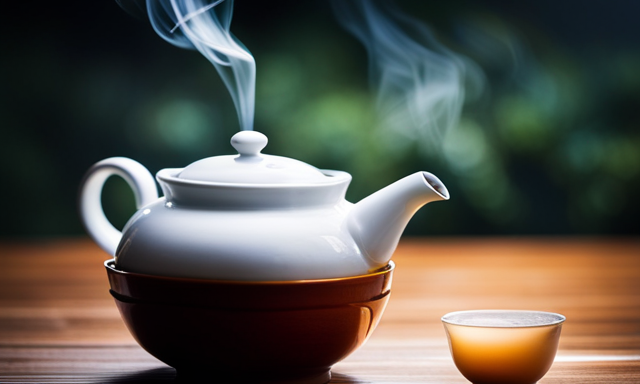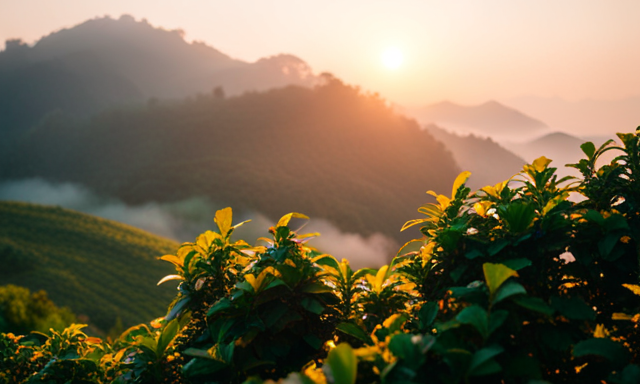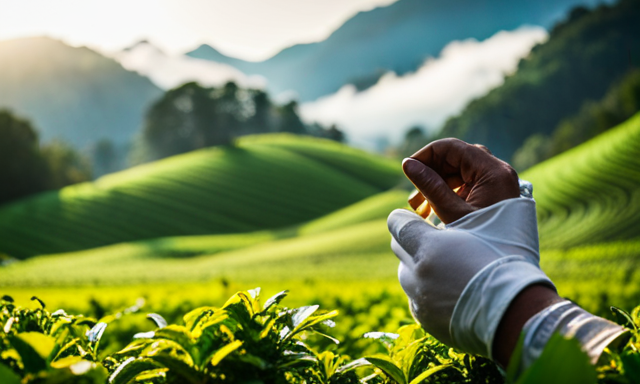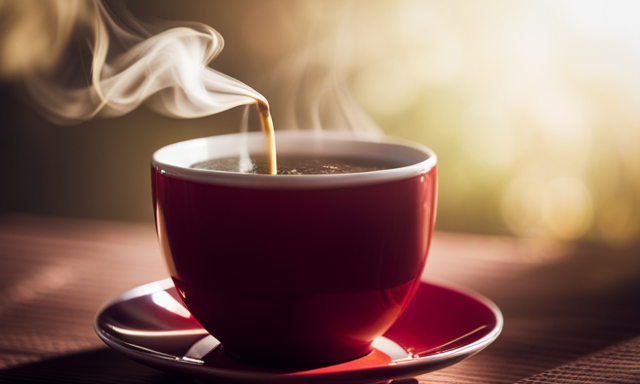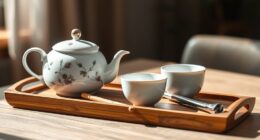Stepping into the world of oolong tea is like embarking on a journey through a lush, aromatic garden. As a tea enthusiast, I have delved into the realms of this fascinating beverage, uncovering its unique flavors and diverse characteristics.
In this article, I will guide you through the process of getting accustomed to the captivating allure of oolong tea. From understanding the basics to finding your preferred varieties, I will provide you with precise and detailed steps to enhance your oolong tea experience.
We will explore the nuances of steeping times and water temperatures, and discover the perfect pairings with complementary foods. By practicing mindfulness and savoring each sip, you will gradually develop a deep appreciation for this daily ritual.
So, join me on this sensory adventure, as we unlock the secrets of oolong tea together.
Key Takeaways
- Gradually increase steeping time to intensify flavors
- Explore different oolong tea varieties to find favorites
- Embrace oolong tea as a daily ritual for its nuanced flavors and health benefits
- Pair specific oolong tea varieties with desired health benefits
Understanding the Basics of Oolong Tea
To truly appreciate oolong tea, it’s crucial to understand the fundamental elements that make it unique.
Oolong tea is a type of tea that falls between green and black tea in terms of oxidation. The understanding of oolong tea processing is key to appreciating its complex flavors and aromas. The leaves undergo partial oxidation, which gives oolong tea its distinct characteristics. This process allows for a wide range of flavors, from floral and fruity to toasty and nutty.
Apart from its delightful taste, oolong tea also offers numerous health benefits. It’s rich in antioxidants, which help combat free radicals and reduce the risk of chronic diseases. Oolong tea is also known to boost metabolism, aid in weight loss, and improve digestion.
Now that we have a grasp on the basics of oolong tea, let’s explore how to start with lighter oolong teas.
Start with Lighter Oolong Teas
Begin your journey into the world of Oolong tea by exploring the delicate and subtle flavors of lighter varieties. Lighter oolong teas are a perfect starting point for those new to this type of tea, as they offer a gentle introduction to its unique taste profile.
These teas have a floral and fruity aroma, with notes of honey and a hint of nuttiness. To fully appreciate their flavors, it’s important to experiment with different oolong tea flavors. From the floral and light Tie Guan Yin to the creamy and buttery Jin Xuan, there are a variety of options to choose from.
Additionally, exploring oolong tea brewing techniques will enhance your experience. Whether you prefer gongfu style or Western-style brewing, these techniques can bring out different aspects of the tea’s flavor.
As you become more familiar with oolong tea, you can then move on to experiment with different steeping times, allowing you to unlock even more complex flavors.
Experiment with Different Steeping Times
When experimenting with different steeping times for oolong tea, it’s important to understand that shorter steeping times yield a lighter flavor, while longer steeping times result in a stronger taste.
Personally, I find that steeping lighter oolong teas for around 2-3 minutes allows the delicate flavors to shine through, creating a gentle and refreshing cup of tea.
On the other hand, steeping for 4-5 minutes or more intensifies the flavors, producing a bolder and more robust brew that’s perfect for those who prefer a stronger taste.
Short Steeping for Lighter Flavor
Short steeping for lighter flavor
Steeping oolong tea for a shorter duration reveals its delicate flavors, like a gentle breeze dancing through a flower-filled garden. To achieve this, it’s important to master the art of short steeping techniques.
Begin by using the optimal water temperature for oolong tea, which is around 180°F (82°C). This temperature allows the leaves to slowly unfurl and release their subtle aromas. For a lighter flavor, steep the tea for only 1-2 minutes. This short duration prevents the extraction of strong, bitter notes, resulting in a more delicate and nuanced taste.
The resulting brew will have a pale golden color and a mild, floral fragrance.
Transitioning into the subsequent section about longer steeping for a stronger taste, we can explore how extended steeping times can bring out a bolder character in oolong tea.
Longer Steeping for Stronger Taste
To achieve a bolder and more robust flavor in your oolong brew, simply let it steep for a longer period of time. Long steeping benefits include extracting more of the tea’s flavors and aromas, resulting in a fuller and stronger taste.
During this extended steeping process, the leaves release their essence, creating a complex and satisfying cup of tea.
Here are some alternative steeping methods to experiment with:
-
Cold steeping: Place the tea leaves in cold water and let them steep in the refrigerator for several hours. This method produces a smooth and refreshing oolong infusion.
-
Gongfu style: Use a smaller teapot and multiple short infusions to extract the tea’s flavors layer by layer. This method is popular among tea connoisseurs for its ability to highlight the tea’s nuances.
By adjusting the water temperature, you can further enhance the taste profile of your oolong tea.
Adjust the Water Temperature
First, make sure you’re using water that’s hot but not boiling for the best oolong tea experience. The water temperature adjustment is crucial in bringing out the delicate flavors of oolong tea.
Ideally, the water should be around 190-200°F (88-93°C). This temperature range allows the leaves to release their unique aromas and flavors without scorching them. To achieve this, you can either let boiling water cool for a few minutes or use a thermometer to measure the temperature accurately.
Steeping techniques also play a role in controlling the strength of your oolong tea. For a stronger taste, you can increase the steeping time, but be careful not to overdo it as it may result in a bitter brew.
With the water temperature and steeping techniques just right, you’re ready to explore the world of oolong tea and discover its perfect pairing with complementary foods.
Pair Oolong Tea with Complementary Foods
Now that you’ve mastered adjusting the water temperature for your oolong tea, let’s move on to the next step: pairing oolong tea with complementary foods.
This is an important aspect of enjoying oolong tea to its fullest potential. When selecting foods to pair with oolong tea, it’s crucial to consider the flavors and aromas of both the tea and the food. Some popular complementary food pairings include light pastries, fresh fruits, and delicate cheeses. These pairings enhance the overall taste experience and create a harmonious balance of flavors.
Additionally, oolong tea has numerous health benefits, including boosting metabolism and promoting heart health. By incorporating complementary foods with oolong tea, you can further maximize these health benefits.
So, let’s delve into the art of pairing oolong tea with complementary foods and discover a whole new level of tea enjoyment.
Next, we’ll explore how to practice mindfulness and savor the experience.
Practice Mindfulness and Savor the Experience
Immerse yourself in the present moment and fully embrace the sensory pleasure of savoring every sip and bite, allowing the flavors and aromas to transport you to a state of pure bliss. To practice mindfulness and enhance the tea drinking experience, focus on each sensation as you indulge in your oolong tea. Notice the color of the tea in your cup, the aroma that wafts up to your nose, and the way the tea feels on your tongue. Pay attention to the subtle flavors that unfold with each sip. To heighten your awareness, try pairing your tea with complementary foods that complement its unique characteristics. For example, a light, floral oolong can be enjoyed with delicate pastries or fresh fruits, while a rich, roasted oolong can be paired with dark chocolate or nuts. By savoring each moment, you can fully appreciate the complexity and beauty of oolong tea. In the next section, we will explore how to gradually increase the strength of oolong tea.
Gradually Increase the Strength of Oolong Tea
To fully enhance the potency of your oolong pleasure, progressively pump up the power of your steeped sensation. Increasing the strength of your oolong tea is an art that requires patience and experimentation.
Start by steeping your tea for the recommended time, usually around 3-5 minutes. As you become more accustomed to the taste, gradually increase the steeping time by 30 seconds to a minute. This will allow the flavors to intensify without becoming overpowering.
You can also try using more tea leaves or reducing the amount of water to create a stronger brew. By slowly adjusting the steeping time and tea strength, you’ll find the perfect balance that suits your taste buds.
In the next section, we’ll explore how to find your preferred oolong tea varieties without limiting your options to just one.
Find Your Preferred Oolong Tea Varieties
Explore a world of tantalizing oolong tea varieties that’ll transport your taste buds to exotic gardens and aromatic landscapes. Finding your preferred oolong tea flavors is an exciting journey of discovery.
From the delicate floral notes of Tie Guan Yin to the rich and roasted flavors of Da Hong Pao, there’s a wide range of options to suit every palate. Experiment with different varieties and explore their unique characteristics to find the ones that resonate with you the most.
Additionally, mastering oolong tea brewing techniques is essential for creating a perfect cup every time. Whether you prefer a shorter steeping time for a lighter taste or a longer infusion for a more robust flavor, understanding the art of brewing will enhance your oolong tea experience.
Embracing oolong tea as a daily ritual allows you to savor its nuanced flavors and enjoy its numerous health benefits.
Embrace Oolong Tea as a Daily Ritual
Indulging in the daily ritual of embracing oolong tea allows me to savor its nuanced flavors and reap its countless health benefits. Oolong tea is not only a delicious beverage, but it also offers a wide range of health benefits. To incorporate oolong tea into my daily routine, I start each morning with a warm cup of oolong tea. Its natural caffeine content provides a gentle energy boost to kickstart my day. Throughout the day, I make it a point to have a few more cups of oolong tea. It helps me stay hydrated and promotes digestion. To make this ritual even more enjoyable, I have created a table that pairs different varieties of oolong tea with specific health benefits, enhancing my overall well-being. By embracing oolong tea as a daily ritual, I am able to fully experience its remarkable qualities and improve my health.
| Oolong Tea Variety | Health Benefit |
|---|---|
| Tie Guan Yin | Boosts metabolism and aids in weight loss |
| Da Hong Pao | Enhances mental alertness and focus |
| Oriental Beauty | Promotes radiant skin and healthy hair |
| Jin Xuan | Supports digestion and gut health |
Frequently Asked Questions
Can I drink oolong tea if I have a caffeine sensitivity?
As someone with a caffeine sensitivity, I don’t recommend drinking oolong tea. It contains caffeine and may not be suitable during pregnancy. However, it has been linked to weight loss in some studies.
What is the best time of day to drink oolong tea?
The best time of day to drink oolong tea is in the morning or early afternoon. Some popular oolong tea brands include Teavana and Twinings. Drinking oolong tea has numerous benefits for health and well-being.
Can I sweeten my oolong tea with honey or sugar?
Yes, you can sweeten your oolong tea with honey or sugar. However, it’s important to note that oolong tea is naturally sweet and adding sweeteners may hide some of its health benefits.
How long does oolong tea stay fresh?
Oolong tea stays fresh for about 1-2 years if stored properly. To store it, keep it in an airtight container away from light, heat, and moisture. Over time, the flavor may diminish, but it doesn’t technically expire.
Can I reuse oolong tea leaves for multiple infusions?
Yes, oolong tea leaves can be reused for multiple infusions. This practice is common and has several benefits, including extracting different flavors and increasing the number of cups you can enjoy from a single batch of leaves.
Conclusion
In conclusion, embracing Oolong tea as a daily ritual is a journey worth taking. By understanding the basics and experimenting with different steeping times, adjusting water temperature, and pairing it with complementary foods, you can gradually increase your appreciation for this exquisite beverage.
Practice mindfulness and savor the experience, allowing yourself to be fully present in each sip. As you find your preferred Oolong tea varieties, you’ll discover a world of flavors and aromas that’ll captivate your senses.
So, embark on this adventure and let Oolong tea become a cherished part of your daily routine.

